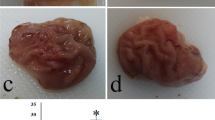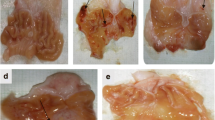Abstract
Although propranolol has been shown to protect against enthanol and stress ulceration, the antiulcer mechanisms are still unclear. The present study examined the antiulcer mechanisms of propranolol in three different types of ulceration induced respectively by ethanol (60%), indomethacin (30 mg/kg) and stress (cold-restraint). Propranolol pretreatment in the highest dose (10 mg/kg) given either intraperitoneally (i.p.) or orally (p.o.) prevented gastric mucosal damage in these three ulcer models. The three doses of the drug (2.5, 5 or 10 mg/kg) dose-dependently decreased systemic blood pressure which was accompanied by a reduction of gastric mucosal blood flow. These findings suggest that the protection was unrelated to an improvement of local circulation in the stomach. However, propranolol preserved the mucus levels in the three types of ulcer models. The β-adrenoceptor blocker also increased the basal gastric mucosal potential difference. These findings indicate that propranolol strengthens the mucosal barrier by the preservation of mucosal mucus and enhancement of the mucosal integrity in the stomach.
Similar content being viewed by others
References
Costa M, Gabella G. Adrenergic innervation of the alimentary canal. Z. Zellforsch Mikrosk Anat 1971;122:357–77.
Sanders DJ. A review: the agents and action of sympathetic nerve and catecholamine inhibition of gastric mucosal function. Agents Actions 1976;6:385–8.
Tepperman BL, Whittle BJ. Comparison of the effects of neuropeptide Y and noradrenaline on rat gastric mucosal blood flow and integrity. Br J Pharmacol 1991;102:95–100.
Gatta A, Sacerdoti D, Merkel C, Rossoni R, Finucci G, Bolongnesi M, et al. Use of a non-selective beta-blocker, nadolol, in the treatment of portal hypertension in cirrhotics. Int J Clin Pharm Res 1985;5:413–8.
Hillon P, Lebrec D, Munoz C, Jungers M, Goldfarb G, Benhamou J. Comparison of the effects of a cardioselective and a non-selective beta-blocker on portal hypertension in patients with cirrhosis. Hepatology 1982;2:528–31.
Olsson R. Beta-receptor blocking treatment in portal hypertension. Scand J Gastroenterol 1990;25:641–6.
Westaby D, Bihari DJ, Gimson AE, Crossley IR, Williams R. Selective and non-selective beta-receptor blockade in the reduction of portal pressure in patients with cirrhosis and portal hypertension. Gut 1984;25:121–4.
Sankary H, Sarfeh IJ, Tarnawski A, Maeda R, Ivey KJ, Mason GR. Propranolol reduces ethanol-induced gastric mucosal damage in portal hypertensive rats. Dig Dis Sci 1986;31:162–5.
Woo PCY, Cho CH. Effect of β-Adrenoceptor antagonists on portal vein hypertension and ethanol-induced gastric mucosal damage in rats. J. Pharm Pharmacol 1994;46:95–7.
Al-Bekairi AM, Al-Rajhi AM, Tariq M. Effect of (±)-propranolol and Clonidine on stress- and chemically induced gastric ulcers in rats. Arch Int Pharmacodyn Ther 1993;323:97–113.
Bhandare P, Diniz D, Souza R, Mainker A, Dhume V. Protective effect of propranolol on ethanol-induced gastric lesions in mice. Eur J Pharmacol 1990;191:167–72.
Jacobson ED. Gastric blood flow and the gastric mucosal barrier. Dig Dis Sci 1985;30 Suppl 11:77S-80.
Szabo S, Cho CH. Animal models for studying the role of eicosanoid in ulcer disease. In: Hiller K, editor. Advances in Eicosanoid Research, Eicosanoids and Gastrointestinal Tract. Lancaster: MPT Press, 1988:75–80.
Senay EC, Levine RJ. Synergism between cold and restraint for rapid production of stress ulcer in rats. Proc Soc Exp Biol Med 1967;124:1221–3.
Cho CH, Ogle CW. Paracetamol potentiates stress-induced gastric ulceration in rats. J Pharm Pharmacol 1990;42:505–7.
McGreevy JM. Gastric surface cell function: potential difference and mucosal barrier. Am J Physiol 1984;247:G79–87.
Menguy R. Gastric mucus and the gastric mucous barrier. A review. Am J Surg 1969;117:806–12.
Junqueira LC, Carneiro J, editors. Basic Histology. Los Altos: Lange, 1985:314–6.
Morales-Aguilera A, Williams EMV. The effects on cardiac muscle of β-receptor antagonists in relation to their activity as local anaesthetics. Br J Pharmacol 1965;24:332–8.
Luk ISC, Ho J, Wong WM, Yuen ST, Luk CT, Cho CH. Influence of chronic nicotine intake and acute ethanol challenge on gastric mucus level and blood flow in rabbits. Digestion 1994;55:399–404.
Mersereau WA, Hinchey EJ. Effect of gastric acidity on gastric ulceration induced by hemorrhage in the rat, utilizing a gastric chamber technique. Gastroenterology 1973;64:1130–5.
Wong SH, Cho CH, Ogle CW. Protection by zinc sulfate against ethanol-induced ulceration: preservation of the gastric mucosal barrier. Pharmacology 1986;33:94–102.
Vane JR. Inhibition of prostaglandin synthesis as a mechanism of action for aspirin-like drugs. Nature 1971;231:232–5.
Canfield SP, Hughes AD, Price CA, Spencer JE. The action of β-adrenoceptor agonist on acid secretion by the rat isolated stomach. J Physiol Lond 1981;316:23–31.
Takeuchi K, Ohno T, Okabe S. Variations of gastric transmucosal potential difference and lesion formation during hemorrhagic shock in the rat. Gastroenterology 1986;91:1113–22.
Sheppard AP, Riedel GL. Continuous measurement of intestinal mucosal blood flow by laser-Doppler velocimetry. Am J Physiol 1982;242:G668–72.
Spenney JG, Shoemaker RL, Sachs G. Characterization of gastric mucosal membranes. Composition of gastric cell membranes and polypeptide fractination using ionic and nonionic detergents. Arch Biochem Biophys 1974;161:456–71.
Cho CH. In vitro study of ethanol on electrical parameters in rat stomachs. Agents Actions 1991;33:378–81.
Takeuchi K, Magee D, Critchlow J, Matthews J, Silen W. Studies of pH gradient and mucus thickness of frog gastric gel. Gastroenterology 1983;84:331–40.
Tasman-Jones C. Gastric mucus-physial properties in cycoprotection. Med J Aust 1985;141:S5–6.
Cho CH, Mei QB, Kaan SK. The intraperitoneal effects of 5-hydroxytryptamine on haemodynamics gastric mucosal blood flow and platelet aggregation. Eur J Pharmacol 1994;256:9–15.
Liu XG, Cho CH, Ko JKS. Felodipine and ethanol-induced gastric mucosal damage in rats. Pharmacology 1995;51:391–7.
Guth PH. Gastric blood flow in ethanol injury and prostaglandin cytoprotection. Scand J Gastroenterol 1986;125 Suppl:86–91.
Nicholson AN, Wright NA, Zetlein MB, Currie D, McDevitt DG. Central effects of β-adrenoceptor antagonists II-electroencephalogram and body sway. Br J Clin Pharmacol 1988;26:129–41.
Nomura T, Fukudo S, Muranaka M, Iwahashi S, Sasaki M, Satake M, et al. Impact of stress on serum gastrin in Zollinger-Ellison syndrome. Am J Gastroenterol 1993;88:1432–5.
Qiu BS, Cho CH, Ogle CW. Effects of nicotine on activity and stress-induced gastric ulcers in rats. Pharmacol Biochem Behav 1992;43:1053–8.
Dekanski JB, MacDonald A, Sacra D, Parke DV. Effects of fastings, stress and drugs on gastric glycoprotein synthesis in the rat. Br J Pharmacol 1975;55:387–92.
Morimoto Y, Shimohara K, Oshima S, Hara H, Sukamoto T. Effects of KB-5492, a new anti-ulcer agent with a selective affinity for the sigma-receptor, on aspirin-induced disruption of the rat gastric mucosal barrier. Jpn J Pharmacol 1994;64:49–55.
Dinoso VP, Ming SC, McNiff J. Ultrastructural changes of the canine gastric mucosa after topical application of graded concentrations of ethanol. Dig Dis Sci 1976;21:626–32.
Kauffman G. Aspirin-induced gastric mucosal injury: lessons learned from animal models. Gastroenterology 1989;96:606–14.
Cho CH, Koo MWL, Garg GP, Ogle CW. Stress-induced gastric ulceration: Its aetiology and clinical implications. Scand J Gastroenterol 1992;27:257–62.
Author information
Authors and Affiliations
Additional information
accepted by R. O. Day
Rights and permissions
About this article
Cite this article
Kaan, S.K., Cho, C.H. A study of the antiulcer mechanisms of propanolol in rats. Inflamm Res 45, 370–375 (1996). https://doi.org/10.1007/BF02252930
Received:
Revised:
Accepted:
Issue Date:
DOI: https://doi.org/10.1007/BF02252930




